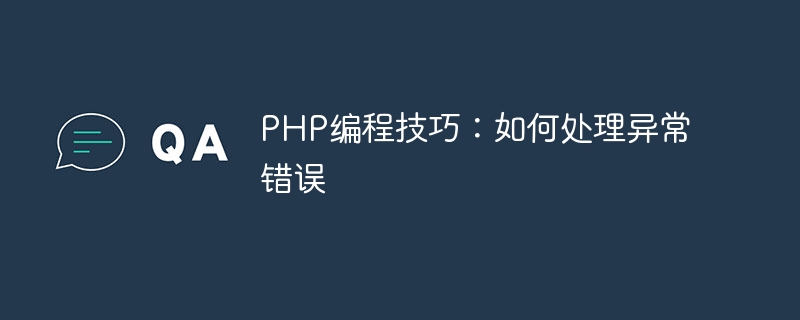

PHP Programming Tips: How to Handle Exception Errors
Introduction:
In PHP development, exception errors (Exception) are problems we often encounter. Handling exception errors is an essential skill for writing robust, stable code. This article will introduce some common PHP exception handling techniques to help developers better handle exception errors.
Basic concept of exception handling:
Exception refers to an event or situation that does not meet expectations. When an exception occurs, the program will interrupt execution and trigger an exception. Exceptions usually contain an error message, error code, and error category or type. Using the exception handling mechanism, we can catch and handle these exceptions to avoid program crashes.
PHP exception handling syntax:
In PHP, you can use the try-catch-finally syntax structure to catch and handle exceptions. The try block contains code that may trigger exceptions, the catch block is used to catch exceptions and handle exceptions, and the code in the finally block will always be executed regardless of whether an exception occurs.
The following is a simple exception handling example:
try {
// 可能会触发异常的代码
$result = 1 / 0;
} catch (Exception $e) {
// 捕获并处理异常
echo "Caught exception: " . $e->getMessage();
} finally {
// 无论异常与否,该块中的代码总是执行
echo "Finally block";
}In the above example, division by zero will trigger an exception, and the catch block will capture the exception and print the exception error message. Finally, the code in the finally block will be executed regardless of exception or not.
Custom exception class:
In addition to using PHP's built-in exception class Exception, we can also customize exception classes. Custom exception classes can provide us with more error information, making it easier for us to locate and debug.
The following is a simple example of a custom exception class:
class CustomException extends Exception {
public function __construct($message, $code = 0, Throwable $previous = null) {
// 调用父类构造函数
parent::__construct($message, $code, $previous);
}
public function __toString() {
// 自定义异常输出格式
return __CLASS__ . ": [{$this->code}]: {$this->message}
";
}
public function customFunction() {
// 自定义的异常处理函数
echo "Custom function for handling exception";
}
}
try {
// 可能会触发异常的代码
throw new CustomException("This is a custom exception");
} catch (CustomException $e) {
// 捕获并处理自定义异常
echo $e;
$e->customFunction();
} catch (Exception $e) {
// 捕获其他类型的异常
echo "Caught exception: " . $e->getMessage();
} finally {
echo "Finally block";
}In the above example, we define a CustomException class, which inherits from Exception. We can add custom properties and methods to the custom exception class, and call these methods to obtain more information when catching exceptions.
Exception throwing and delivery:
During the development process, we may need to catch and handle exceptions in a certain function, and then throw the exception to the upper calling function for processing.
The following is an example of exception throwing and delivery:
function foo() {
try {
// 可能会触发异常的代码
throw new Exception("Exception in foo function");
} catch (Exception $e) {
// 捕获并处理异常
echo "Caught exception: " . $e->getMessage();
// 抛出异常到上层调用函数中
throw $e;
}
}
try {
// 调用函数foo
foo();
} catch (Exception $e) {
// 捕获并处理上层抛出的异常
echo "Caught exception in catch block: " . $e->getMessage();
}In the above example, function foo catches and handles the exception, and throws the exception to the upper calling function. The upper layer calling function will also catch and handle this exception.
Conclusion:
Exception handling is an important skill in PHP programming. Through a good exception handling mechanism, we can better handle exception errors and ensure the robustness and stability of the code. This article introduces the basic concepts and syntax of exception handling, as well as custom exception classes and exception throwing and delivery. Hopefully these tips can help developers write better PHP code.
The above is the detailed content of PHP Programming Tips: How to Handle Exception Errors. For more information, please follow other related articles on the PHP Chinese website!
 How to solve 0xc000409 error
How to solve 0xc000409 error
 How to solve the WerFault.exe application error
How to solve the WerFault.exe application error
 What keys do arrows refer to in computers?
What keys do arrows refer to in computers?
 The difference and connection between c language and c++
The difference and connection between c language and c++
 Check out the top ten cryptocurrencies worth investing in
Check out the top ten cryptocurrencies worth investing in
 what is wechat
what is wechat
 Which company does Android system belong to?
Which company does Android system belong to?
 Usage of floor function
Usage of floor function




